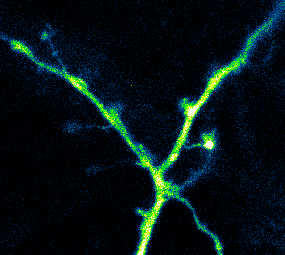Ehud Isacoff
Biologist Faculty Scientist
Professor, Molecular and Cell Biology, UC Berkeley
Director, Helen Wills Neuroscience Institute

Building: Life Sciences Addition, Room 271
Phone: (510) 642-9853
EYIsacoff@lbl.gov
https://vcresearch.berkeley.edu/faculty/ehud-isacoff
Links
Research Interests
Our lab’s research is focused in four intersecting and complementary areas: mechanisms of ion channel function, synapse development and plasticity, neural circuit function, and the design of novel probes for the optical detection of neuronal signaling.

Developing Tools to Study Neurons
Elucidating structural and functional connectivity between neurons is one of today’s greatest challenges of systems neuroscience. We have developed a family of genetically-encoded photoactivatable calcium sensors that allow us to simultaneously visualize the morphology and activity of individual neurons, including fine structures such as dendritic spines.
Recent Publications
Related News
Biosciences Researchers Honored by the National Academy of Sciences
Three scientists affiliated with the Biosciences Area have been recognized by the National Academy of Sciences (NAS), one as the recipient of an NAS award and two as newly elected members. On Sunday, the NAS formally presented its 2018 NAS Award in Chemical Sciences to Jennifer Doudna, a faculty biochemist in the Molecular Biophysics and Integrated Bioimaging (MBIB) Division. Judith Campisi, a biochemist affiliated with Biological Systems and Engineering Division, Ehud “Udi” Isacoff, an MBIB faculty biologist, are among the group of 84 new members elected to the NAS.
DARPA Awards $21.6M to Develop Optogenetic ‘Read-Write’ Neural Interface
Ehud Isacoff of the Molecular Biophysics and Integrated Bioimaging (MBIB) Division is the project lead on a $21.6 million grant awarded to UC Berkeley as part of the Defense Advanced Research Projects Agency’s (DARPA’s) Neural Engineering System Design program. The team led by Isacoff, director of the Helen Wills Neuroscience Institute at UC Berkeley, aims to develop a novel brain-machine interface that uses light to monitor and modulate the activity of thousands to millions of individual neurons in the cerebral cortex.



